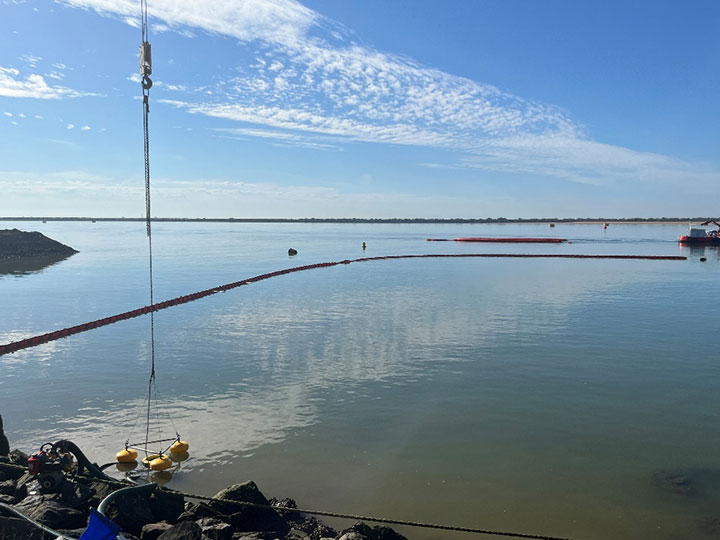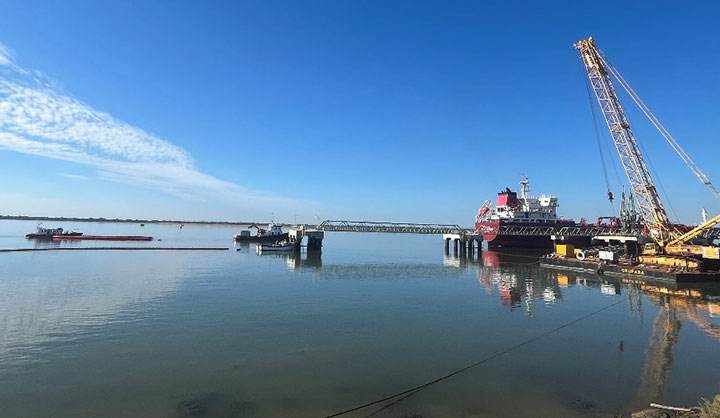Landfill sources (A_10)
The water pollution hotspots present in the port(s) in order of relevance are:
| Origin of the discharge | Order of relevance4 |
|---|---|
| Rivers, streams, wadis or irrigation ditches | 1 |
| Industrial discharges from port concessions | 2 |
| Unregulated discharges from ships (bilges, etc.) | 3 |
| Refuelling and provisioning of vessel at quayside | 4 |
| Accidental spills during loading/unloading of bulk liquids | 5 |
| Bad practices in cleaning and maintenance of docks and equipment | 6 |
| Spills in loading/unloading of bulk solids | 7 |
| Dredging | 8 |
| Urban Treated Waste Water (WWTP's) | 9 |
| Cleaning and sandblasting of ship hulls | 10 |
| Works | 11 |
| Unchannelled or untreated rainfall or irrigation runoffs | NA |
| Untreated urban waste water | NA |
| Bunkering of vessels at anchor | NA |
| Other discharges (please specify) | NA |
4) The order of relevance is listed in ascending order from 1 onwards. NA, Not Applicable.
The main cause of deterioration of water quality in the harbour is upstream discharges into rivers, streams, including acid mine drainage. An inventory and characterisation of the different sources of discharge and pollution of the port’s waters has been carried out.
Measures adopted by the Huelva Port Authority for the control of discharges (A_11)

The measures implemented for the improvement and control of water quality in the port of Huelva are as follows:
- Muelle Sur drainage connection.
- Collection of water from the docks and improvement of the pavement at the Muelle Ing. J. Gonzalo and Muelle C. de Palos docks.
- Connection of the sewerage system to the basic network around the Columbus monument.
- Periodic water and sediment quality characterisation campaigns.
- Direct supervision on the quayside by Port Authority technicians.
- Installation of areas for cleaning and maintenance of equipment.
- Improvements in runoff management (collection, channelling, coarse wells, storm tanks, etc.).
- Specific environmental requirements on waste water and run-off management under concession conditions.
- Environmental requirements on maintenance and cleaning of equipment in service specifications and award conditions.
- Good practice agreements.
- Approval of Inland Marine Pollution Emergency Response Plans (IMPs).
- Improvement in the provision of own resources for the fight against accidental marine pollution.
All binding environmental authorisations are reviewed during the audits for good housekeeping bonus payments. In addition, the Department of Sustainability and Energy Transition has been carrying out important work to monitor all these requirements.
In 2024, the Port Authority of Huelva completed the project for the connection of the sewerage system to the basic network at Muelle Sur.
The total budget for the implementation of the project was EUR 2.5 million.
Water quality characterisation campaigns (A_12)
During 20245 a water quality monitoring campaign was carried out in the Service Area, related to the dredging works. Typically, the type of parameters measured during these characterisation campaigns are: dissolved oxygen, pH, redox potential, conductivity, temperature, salinity, turbidity, suspended solids, total nitrogen, phosphates, oxidisable organic carbon and metals (mercury, cadmium, lead, copper, zinc, chromium, nickel and arsenic).
5) In relation to the EIS Resolution of 22 January 2018 and Resolution of 10 December 2024, of the Directorate General for Environmental Quality and Assessment and the Environment.
Sewerage and wastewater treatment network (A_13)
In the Service Area of the Port of Huelva for the area destined for industrial use, the installations have their own sewage network with connection to the municipal network. In relation to the rest of the area with port uses, there is also an extensive sewage network that collects wastewater and takes it to the Municipal Wastewater Treatment Plant for final treatment.
In detail, the proportion is as shown in the table below:
| Type of treatment | % of area6 |
|---|---|
| Percentage of the area of the land service area with sewerage network (irrespective of where it discharges and the treatment received) | 100.0 |
| Percentage of the area of the land service area with sewerage connected to the municipal sewerage system or to a WWTP | 99.9 |
| Percentage of land area discharging to septic tanks | 0.01 |
6) These percentages refer to the service area of the port with facilities and in which port operations are or may be carried out. The area of the service area corresponding to marshland and without facilities has been disregarded for this list.
Runoff water treatment (A_14)
In relation to runoff water, the degree of runoff water collection coverage is indicated below:
| Type of network | % of area7 |
|---|---|
| Percentage of land area with runoff collection network. | 100% |
| Percentage of the surface area of the Service Area with runoff water collection and treatment. | 100% |
7) It should be noted that these percentages are percentages in relation to the service area in which activities are or may be carried out. The area of the service area, which corresponds to marshland and has no facilities, has been disregarded.
A storm water tank is currently in use to collect storm water at the Muelle Ingeniero Juan Gonzalo.
Schematic description of the technical means used for cleaning the sheet of water and weight of flotsam collected in the year (A_15)
On 29 July 2022, a contract was signed for the support to the maintenance of the aids to navigation and the fight against marine pollution of the Port Authority of Huelva 2022-2027, which includes the cleaning of the water surface, for a period of 3 years, extendable for a further 2 years at the discretion of the APH.
The following table gives details of the service for the cleaning of floats on the water surface of the port during 2024:
| No of vessels | 3 |
| Frequency of cleaning | In the presence of floating elements |
| Weight of waste collected in mt | 4.795 |
Activation of the Maritime Interior Plan (MIP) (A_16)
| Number of marine pollution incidents that did not require activation of the MIP* | 0 |
| Number of marine pollution emergencies that have required the activation of the MIP. Of any concession without activation of the Port's IMP ("Alert") | 3 |
| Number of marine pollution emergencies that have required the activation of the Port's MIP ("Alert") (**) | 4 |
| Number of marine pollution emergencies that have required the activation of the National Maritime Plan ("situation 1 or higher") | 0 |
(*): According to the procedures established in the APH PIM, the activation of the PIM of any concession requires the activation of the APH PIM at least in the alert phase.
(**): Activation of the HPA MIP in Emergency Phase, Response Level 1.

Volume of waste water discharges generated by the Port Authority, or discharged through sewers owned by the Port Authority, broken down by type (A_17)
The activities of the Port Authority of Huelva that generate wastewater discharges come from:
- Offices, Muelle Levante: ARU (Urban Waste Water)
- Muelle Sur: ARU (Urban Waste Water)
- Muelle Ingeniero Juan Gonzalo: ARI (Industrial Waste Water)
The destination of such waste water:
| Municipal sewer | Offices and Muelle Levante (Rainwater drains) |
| Sanitation network | Muelle Sur (Offices): connection to sewerage system |
| Own treatment | In operation at Muelle Ingeniero Juan Gonzalo: storm water tank |
The water discharged into the estuary is all rainwater. There are different points of clean rainwater in the service area that, due to their condition, do not require treatment and do not have flow or volume measuring devices.